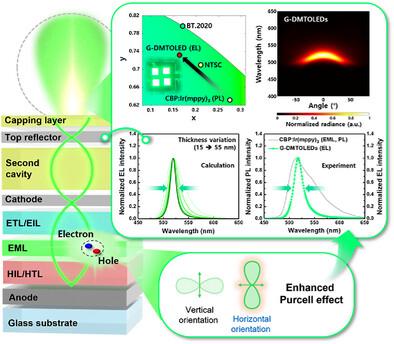双微腔有机发光二极管的purcell增强光谱精确发射
IF 19
1区 材料科学
Q1 CHEMISTRY, MULTIDISCIPLINARY
引用次数: 0
摘要
开发光谱精确、紧凑的电致发光(EL)器件对于新兴的光子技术至关重要,包括先进的显示和集成光子系统。尽管发射极材料的最新进展使全宽半最大值(FWHM)值低至25 nm的窄带发射成为可能,但其实际应用受到稳定性问题、制造复杂性和有限的环境兼容性的阻碍。光学微腔通过高质量因素提高光谱精度,但需要复杂的反射器结构和同时进行光学和电学优化。本文提出了一种通用策略,通过双微腔共振增强Purcell效应,实现宽带有机发光二极管(oled)的光谱精确发射。OLED顶部的次级腔将光学和电气设计分离,同时产生双微腔共振。激子与双微腔之间的耦合增强了珀塞尔效应,导致自发发射速率增加。光谱可调的磷光oled(本征FWHM = 60 nm)的超纯绿色发射(FWHM = 21 nm),实现了约65%的光谱窄化。该器件还具有1.241 × 105 cd m−2的高亮度、强方向性和抑制效率滚降的特点。我们的方法与最先进的发射器、极化子和光子结构兼容,为需要从紧凑的EL设备发出单色发射的先进光子系统提供了一条有希望的途径。本文章由计算机程序翻译,如有差异,请以英文原文为准。

Purcell-Enhanced Spectrally Precise Emission in Dual-Microcavity Organic Light-Emitting Diodes
Developing spectrally precise, compact electroluminescent (EL) devices is critical for emerging photonic technologies, including advanced displays and integrated photonic systems. Although recent advances in emitter materials have enabled narrowband emission with full width at half maximum (FWHM) values as low as 25 nm, their practical applications are hindered by stability issues, fabrication complexity, and limited environmental compatibility. Optical microcavities improve spectral precision through high-quality factors but require complex reflector structures and simultaneous optical and electrical optimization. Here, a universal strategy is presented to achieve spectrally precise emission from broadband organic light-emitting diodes (OLEDs) by enhancing the Purcell effect through dual-microcavity resonances. A secondary cavity atop the OLED separates optical and electrical design while generating dual-microcavity resonances. Coupling between excitons and dual-microcavity enhances the Purcell effect, leading to an increased spontaneous emission rate. Spectrally tunable, ultrapure green emission (FWHM = 21 nm) is demonstrated from phosphorescent OLEDs (intrinsic FWHM = 60 nm), achieving ≈65% spectral narrowing. The devices also exhibit a high luminance of 1.241 × 105 cd m−2, strong directionality, and suppressed efficiency roll-off. Our approach is compatible with state-of-the-art emitters, polaritons, and photonic architecture, offering a promising route toward advanced photonic systems requiring monochromatic emission from compact EL devices.
求助全文
通过发布文献求助,成功后即可免费获取论文全文。
去求助
来源期刊

Advanced Functional Materials
工程技术-材料科学:综合
CiteScore
29.50
自引率
4.20%
发文量
2086
审稿时长
2.1 months
期刊介绍:
Firmly established as a top-tier materials science journal, Advanced Functional Materials reports breakthrough research in all aspects of materials science, including nanotechnology, chemistry, physics, and biology every week.
Advanced Functional Materials is known for its rapid and fair peer review, quality content, and high impact, making it the first choice of the international materials science community.
 求助内容:
求助内容: 应助结果提醒方式:
应助结果提醒方式:


